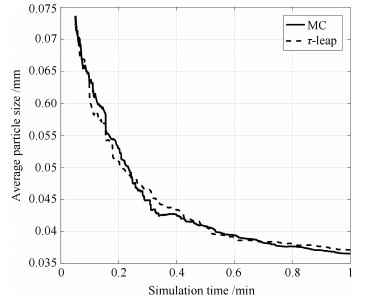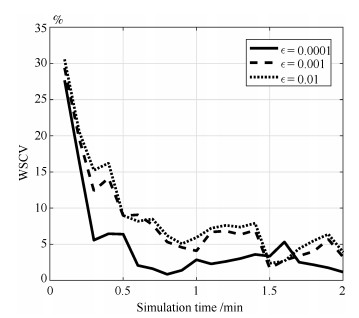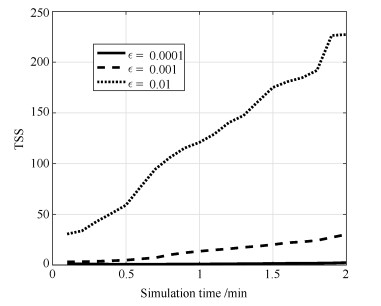A Distributed Parameter Kinetic Monte Carlo Simulation Algorithm of Grinding Process and Its Acceleration
-
摘要: 本文针对磨矿破碎过程,提出一种分布式参数蒙特卡洛动力学方法的粒度分布预测模型和模拟算法.该算法采用了分段思想,将磨机沿着轴向分为若干个虚拟的子磨机;根据破裂、前向和后向移动三类微观事件定义了倾向函数和系统状态矩阵,并设计了分布式算法的调度策略.此外,针对蒙特卡洛动力学算法效率低的问题,提出了基于τ-leap的磨矿过程分布式参数蒙特卡洛模拟加速算法.为了解决分布式参数更新过程中状态不一致的问题,创新性地提出了一种基于缓冲区的同步方法.通过对仿真案例的分析表明,本文提出的分布式参数蒙特卡洛动力学算法具有较高的精度,提出的基于τ-leap的加速算法能够显著提高计算效率,同时保持较好的精度.Abstract: In this paper, we propose a prediction model for the particle size distribution of grinding process and a kinetic Monte Carlo simulation algorithm. The algorithm is based on the idea of dividing the mill into several virtual grinding machines along the axial direction. The preference function and the system state matrix are defined according to three kinds of microcosmic events, breakage, forward movement and back movement, and the scheduling strategy of distributed algorithm is designed. In addition, in view of the low efficiency of the kinetic Monte Carlo algorithm, a Monte Carlo simulation acceleration algorithm based on τ-leap is proposed. In order to solve the problem of inconsistent state when updating the distributed parameters, a new buffer based method is proposed. Case study based on simulation shows that the distributed parameter Monte Carlo dynamic algorithm proposed in this paper has high precision, and the proposed algorithm based on τ-leap can significantly improve the computational efficiency while maintaining good accuracy.1) 本文责任编委 吴立刚
-
表 1 离散差分数值算法和$\tau$-leap方法相对于分布参数MC算法的相对误差比较
Table 1 The relative errors of the discrete numerical algorithm and the $\tau$-leap algorithm with the MC algorithm
子磨机编号 1 2 3 4 5 6 7 8 9 10 第1组 最大误差 8.6 3.8 4.9 7.2 8.6 7.2 5.8 6.7 5.4 5.7 $(\times 10^{-3})$ 平均误差 2.2 0.7 1.0 2.1 2.9 1.2 2.2 2.7 1.9 2.7 %第2组 最大误差 4.4 3.3 7.3 7.2 1.1 7.5 6.4 1.1 9.5 6.7 $(\times 10^{-3} )$ 平均误差 1.0 1.2 1.7 1.8 3.1 2.2 2.6 2.9 1.4 1.8 表 2 基于$\tau$-leap的加速算法在不同$\epsilon$取值下与分布式参数MC算法的$M_p $的相对误差($\%$)
Table 2 The relative difference of $M_p $ ($\%$) of the $\tau$-leap acceleration algorithm comparing with the MC algorithm
$t$ (min) 0$\sim$0.1 0.1$\sim$0.2 0.2$\sim$0.3 0.3$\sim$0.4 0.4$\sim$0.5 0.5$\sim$0.6 0.6$\sim$0.7 0.7$\sim$0.8 0.8$\sim$0.9 0.9$\sim$1.0 $M_p $ ($\epsilon$ = 1$\times10^4$) 0.0125 0.0077 0.0038 0.0034 0.0037 0.0029 0.0025 0.0019 0.0023 0.0026 $M_p $ ($\epsilon$ = 1$\times10^3$) 0.2654 0.1426 0.0802 0.0738 0.0665 0.0738 0.0671 0.0533 0.0516 0.0532 $M_p $ ($\epsilon$ = 1$\times10^2$) 0.4565 0.3605 0.1825 0.0770 0.1720 0.1649 0.1071 0.0819 0.0809 0.0426 $t$ (min) 1.0$\sim$1.1 1.1$\sim$1.2 1.2$\sim$1.3 1.3$\sim$1.4 1.4$\sim$1.5 1.5$\sim$1.6 1.6$\sim$1.7 1.7$\sim$1.8 1.8$\sim$1.9 1.9$\sim$2.0 $M_p $ ($\epsilon$ = 1$\times10^4$) 0.0019 0.0035 0.0044 0.0044 0.0035 0.0035 0.0027 0.0026 0.0028 0.0023 $M_p $ ($\epsilon$ = 1$\times10^3$) 0.0471 0.0580 0.0328 0.0420 0.0448 0.0337 0.0369 0.0488 0.0528 0.0445 $M_p $ ($\epsilon$ = 1$\times10^2$) 0.0447 0.0586 0.0495 0.0504 0.0524 0.0574 0.0534 0.0559 0.0872 0.1015 表 3 基于$\tau$-leap的加速算法在不同$\epsilon$取值下与分布式参数MC算法的$M_p $的相对误差($\%$)
Table 3 The relative difference of $M_p $ ($\%$) of the $\tau$-leap acceleration algorithm comparing with the MC algorithm
$t$ (min) 0$\sim$0.1 0.1$\sim$0.2 0.2$\sim$0.3 0.3$\sim$0.4 0.4$\sim$0.5 0.5$\sim$0.6 0.6$\sim$0.7 0.7$\sim$0.8 0.8$\sim$0.9 0.9$\sim$1.0 WSCV ($\epsilon$ = 1$\times10^4$) 27.6599 16.4219 5.5694 6.4539 6.3902 2.0711 1.6268 0.8461 1.4014 2.8565 WSCV ($\epsilon$ = 1$\times10^3$) 29.3654 19.5643 12.4057 14.1440 8.9499 9.0685 7.7018 5.3212 4.5702 4.0914 WSCV ($\epsilon$ = 1$\times10^2$) 30.5564 20.5641 15.235 16.2165 8.9873 8.1839 8.4892 6.1973 5.0565 5.9391 $t$ (min) 1.0$\sim$1.1 1.1$\sim$1.2 1.2$\sim$1.3 1.3$\sim$1.4 1.4$\sim$1.5 1.5$\sim$1.6 1.6$\sim$1.7 1.7$\sim$1.8 1.8$\sim$1.9 1.9$\sim$2.0 WSCV ($\epsilon$ = 1$\times10^4$) 2.2858 2.6192 3.0302 3.5939 3.3510 5.3169 2.5186 2.1569 1.7443 1.1591 WSCV ($\epsilon$ = 1$\times10^3$) 6.6934 6.8302 6.3439 6.9364 1.6810 2.7825 3.3907 4.0133 5.6812 3.2316 WSCV ($\epsilon$ = 1$\times10^2$) 7.2165 7.6127 7.3752 7.9085 2.3725 2.6708 4.3917 5.4931 6.3914 3.9081 表 4 基于$\tau$-leap的加速算法相对于分布式参数MC算法的TSS加速倍数
Table 4 The magnitude of speedup achieved by $\tau$-leap over the MC algorithm
$t$ (min) 0$\sim$0.1 0.1$\sim$0.2 0.2$\sim$0.3 0.3$\sim$0.4 0.4$\sim$0.5 0.5$\sim$0.6 0.6$\sim$0.7 0.7$\sim$0.8 0.8$\sim$0.9 0.9$\sim$1.0 TSS ($\epsilon$ = 1$\times10^4$) 1.2654 1.0361 1.0256 0.8022 0.8122 0.8222 0.8322 0.8461 0.8522 0.9578 TSS ($\epsilon$ = 1$\times10^3$) 3.0340 3.2120 3.6136 4.1904 4.7486 6.0206 7.1760 10.1046 12.0586 13.5427 TSS ($\epsilon$ = 1$\times10^2$) 30.5564 33.6722 42.8775 50.7719 59.0955 77.1530 94.5627 106.1508 115.3813 120.9510 $t$ (min) 1.0$\sim$1.1 1.1$\sim$1.2 1.2$\sim$1.3 1.3$\sim$1.4 1.4$\sim$1.5 1.5$\sim$1.6 1.6$\sim$1.7 1.7$\sim$1.8 1.8$\sim$1.9 1.9$\sim$2.0 TSS ($\epsilon$ = 1$\times10^4$) 1.0695 1.1649 1.2973 1.3904 1.5310 1.6498 1.7270 1.8265 1.9938 2.3590 TSS ($\epsilon$ = 1$\times10^3$) 14.8307 15.9210 17.4453 18.5544 20.0657 21.9578 22.8312 24.1852 27.2161 30.1375 TSS ($\epsilon$ = 1$\times10^2$) 129.0026 140.3950 147.3712 161.3876 175.1282 180.8352 184.7492 191.9528 226.3620 227.326 -
[1] Chai T Y. Optimal operational control for complex industrial processes. The International Federation of Automatic Control, 2012, 722-731 https://www.sciencedirect.com/science/article/pii/S1367578814000066 [2] Wang X L, Wang Y L, Yang C H, Xu D G, Gui W H. Hybrid modeling of an industrial grinding-classification process. Powder Technology, 2015, 279(7):75-85 http://www.wanfangdata.com.cn/details/detail.do?_type=perio&id=2266f26bbab8fb16cf65ee99acbad2c8 [3] Zhou P, Chai T Y, Wang H. Intelligent optimal-setting control for grinding circuits of mineral processing process. IEEE Transactions on Automation Science and Engineering, 2009, 6(4):730-743 doi: 10.1109/TASE.2008.2011562 [4] Dai W, Zhou P, Zhao D Y, Lu S W, Chai T Y. Hardware-in-the-loop simulation platform for supervisory control of mineral grinding process. Powder Technology, 2016, 288(Supplement C):422-434 http://www.wanfangdata.com.cn/details/detail.do?_type=perio&id=e8814690c2a8cab20abb98292e02cd38 [5] Lu S W, Zhou P, Chai T Y, Dai W. Modeling and simulation of whole ball mill grinding plant for integrated control. IEEE Transactions on Automation Science and Engineering, 2014, 1(4):1004-1019 http://www.wanfangdata.com.cn/details/detail.do?_type=perio&id=a303e693f3001ea5460d0f447ae32e0f [6] Zhou P, Lu S W, Yuan M, Chai T Y. Survey on higher-level advanced control for grinding circuits operation. Powder Technology, 2016, 288(Supplement C):324-338 http://www.wanfangdata.com.cn/details/detail.do?_type=perio&id=af33416855da7824ffb08730514bd0e5 [7] Ballantyne G R, Powell M S. Benchmarking comminution energy consumption for the processing of copper and gold ores. Minerals Engineering, 2014, 65:109-114 doi: 10.1016/j.mineng.2014.05.017 [8] 化成城, 王宏, 卢绍文, 王宏.面向知识自动化的磨矿系统操作员脑认知特征与控制效果的相关分析.自动化学报, 2017, 43(11):1898-1907 http://www.aas.net.cn/CN/abstract/abstract19165.shtmlHua Cheng-Cheng, Wang Hong, LU Shao-Wen, Wang Hong. Knowledge automation-oriented brain cognitive feature and control effect analysis of operator in mineral grinding process. Acta Automatica Sinica, 2017, 43(11):1898-1907 http://www.aas.net.cn/CN/abstract/abstract19165.shtml [9] Pani A K, Mohanta H K. Soft sensing of particle size in a grinding process:Application of support vector regression, fuzzy inference and adaptive neuro fuzzy inference techniques for online monitoring of cement fineness. Powder Technology, 2014, 264(9):484-497 https://www.sciencedirect.com/science/article/pii/S003259101400518X [10] Zhang W, You C F. Numerical approach to predict particle breakage in dense flows by coupling multiphase particle-in-cell and monte carlo methods. Powder Technology, 2015, 283(10):128-136 http://www.wanfangdata.com.cn/details/detail.do?_type=perio&id=d57aa1adef2fd57e7f72f56d27a6464f [11] King R P. Modeling and Simulation of Mineral Processing Systems. Butterworth-Heinemann, Oxford, Second Edition, 2001 [12] Lynch A J, Morrison R D. Simulation in mineral processing history, present status and possibilities. The Journal of The South African Institute of Mining and Metallurgy, 1999, 99(4):283-288 http://www.wanfangdata.com.cn/details/detail.do?_type=perio&id=efc4c839de26f93824c1708631ba6bd7 [13] Ramkrishna D. Analysis of population balance-iv:The precise connection between Monte Carlo simulation and population balances. Chemical Engineering Science, 1981, 36(7):1203-1209 doi: 10.1016/0009-2509(81)85068-3 [14] Berthiaux H. Analysis of grinding processes by markov chains. Chemical Engineering Science, 2000, 55(19):4117-4127 doi: 10.1016/S0009-2509(00)00086-5 [15] Hasseine A, Senouci S, Attarakih M, Bart H J. Application of two analytical approaches for the solution of the population balance equations:Particle breakage process. Chemical Engineering and Technology, 2015, 38(9):1574-1584 doi: 10.1002/ceat.201400769 [16] 苏军伟, 顾兆林, Yun X X.离散相系统群体平衡模型的求解算法.中国科学.化学, 2010, 40(2):144-160 http://www.wanfangdata.com.cn/details/detail.do?_type=perio&id=zgkx-cb201002004Su Jun-Wei, Gu Zhao-Lin, Yun X X. Advances of solution methods of population balance equation for disperse phase system. Scientia Sinica Chimica, 2010, 40(2):144-160 http://www.wanfangdata.com.cn/details/detail.do?_type=perio&id=zgkx-cb201002004 [17] 卢绍文, 余策.磨矿粒度动态过程的一种快速Monte Carlo仿真方法.自动化学报, 2014, 40(9):1903-1911 http://www.aas.net.cn/CN/abstract/abstract18460.shtmlLu Shao-Wen, Yu Ce. A fast Monte Carlo algorithm for dynamic simulation of particle size distribution of grinding processes. Acta Automatica Sinica, 2014, 40(9):1903-1911 http://www.aas.net.cn/CN/abstract/abstract18460.shtml [18] Mishra B K. Monte Carlo Method for the Analysis of Particle Breakage, chapter 15. Elsevier, 2007, 637-660 [19] Khalili S, Lin Y L, Armaou A, Matsoukas T. Constant number Monte Carlo simulation of population balances with multiple growth mechanisms. AIChE Journal, 2010, 56(12):3137-3145 doi: 10.1002/aic.12233 [20] Yu M J, Lin J Z, Cao J J, Seipenbusch M. An analytical solution for the population balance equation using a moment method. Particuology, 2015, 18:194-200 doi: 10.1016/j.partic.2014.06.006 [21] Lu S W. Acceleration of kinetic Monte Carlo simulation of particle breakage process during grinding with controlled accuracy. Powder Technology, 2016, 301(Supplement C):186-196 http://www.wanfangdata.com.cn/details/detail.do?_type=perio&id=99970805b132e60136e084e7a1547a19 [22] Gillespie D T. Stochastic simulation of chemical kinetics. Annual Review of Physical Chemistry, 2007, 58(1):35-55 doi: 10.1146/annurev.physchem.58.032806.104637 [23] Kis P B, Mihalyko C, Lakatos B G. Discrete model for analysis and design of grinding mill-classifier systems. Chemical Engineering and Processing, 2006, 45(5):340-349 doi: 10.1016/j.cep.2005.09.006 [24] Battaile C C. The kinetic Monte Carlo method:Foundation, implementation, and application. Computer Methods in Applied Mechanics and Engineering, 2008, 197(41-42):3386-3398 doi: 10.1016/j.cma.2008.03.010 [25] Liu X, Lu S W. Acceleration of the dynamic simulation of grinding particle size distribution based on tau-leap method. In:Proceedings of the 11th World Congress on Intelligent Control and Automation (WCICA). Shenyang, China:2014, 772-776 -





 下载:
下载:







